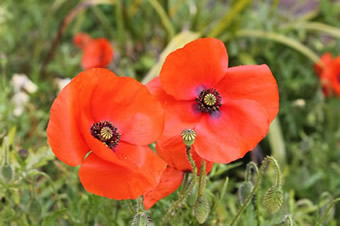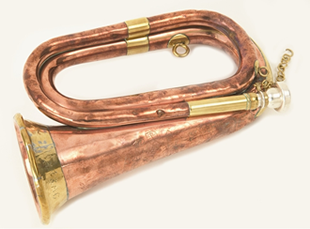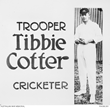|
The Centenary of Anzac is of significance to all Australians. The First World War changed Australia as a nation and helped to forge a national identity through the service and sacrifice of Australians. The centenary remembers the service men and women who went to war and the large numbers who never returned, were injured or maimed. This resource supports quality teaching and learning through specific curriculum learning opportunities to engage all students, as well as enhancing whole school and community interactions and events. Identifying syllabus related learning supports the engagement of all students in commemorating the Centenary of Anzac through integrated learning. |
 ©Public domain (Mary Greenless) |

Engraved bugle: N R Webb, AIF — click image for more information
©AWM (AWM REL31696)
The marking of 100 years since the First World War adds a rich layer of significance to the commemorative activities schools undertake for ANZAC Day and Remembrance Day. This includes:
-
strengthening ties within their local community using a range of initiatives related to the commemoration, such as adopting a local veteran
-
identifying and researching a veteran from local war memorials or memorial boards
-
contributing to the ongoing recognition and preservation of local memorials
-
events, such as tree planting, to commemorate war effort events of specific significance to the local community
-
opportunities for recognition of service by Indigenous Australians, with a specific emphasis on the telling of local stories to enhance reconciliation.
A focus on forging links with schools' local communities allows for the inclusion of a diverse range of perspectives.
Schools can also ensure that current serving soldiers and local veterans are included in a manner that is appropriate for the local community, which may include developing or enhancing a relationship with the local Returned Services League (RSL).
The opportunity for parents and citizens to take a key role in linking school and community to bring communities together.
NSW public schools develop teaching and learning to support the significance of:
-
Australia’s involvement in the First World War and the results of this involvement
-
the First World War to all Australians
-
the impact of the First World War on developing Australian identities then and now.
‘Bringing Communities Together’ supports diverse Australian communities to engage with this commemoration.
The NSW syllabuses provide a valid context for teachers to identify and teach about Australia’s military and community sacrifices in a meaningful way. This ensures future generations inherit the legacy of contemporary, respectful commemorations that recognise more than a century of service by men and women in the wars, conflicts and peacekeeping operations.
The First World War was declared 4 August 1914 when Australia’s population was less than five million.
Prime Minister Andrew Fisher pledged full government support.
-
416 809 men enlisted
-
over 60 000 were killed
-
156 000 were wounded, gassed, or taken prisoner
Australia had the highest per capita casualties, killed and wounded, of any country, including:
-
over 23 000 casualties in the Pozières battles on the Western Front from 23 July to 7 August, 1916
-
38 000 killed or wounded in the battles of Ypres in 1917.
An armistice was agreed to on 11 November 1918, ending the war.
View a Timeline: Australia in the First World War, 1914–1918
Links to ‘Statistics’ image gallery sources.
NSW provided significant support:
-
Between 1914 and 1918, 164 000 people from NSW enlisted in the Australian Imperial Force (AIF), the Australian Naval and Military Expeditionary Force (ANMEF), with an additional 3000 men enlisting in the Royal Australian Navy.
-
Nearly 40% of eligible recruits between the ages of 18 and 44 in NSW enlisted, the highest percentage from any state.
-
Over 50% of all NSW AIF recruits were wounded or killed; of the over 22 000 recruits killed, all except one were buried overseas.
-
Units from NSW took part in all major conflicts in the First World War including Gallipoli, the Somme, Passchendaele, and Bullecourt.
-
Famous units from NSW include the 1st Battalion of the 1st Brigade of the 1st Division, 12th Light Horse, and the 45th Battalion.
-
The Small Arms Factory (SAF) at Lithgow produced British service rifles, which were also used by Australians, with 100 000 manufactured between August 1913 and July 1918.
-
In 1913, Cockatoo Island became the Royal Australian Navy’s Naval Dockyard.
-
The BHP Newcastle Steelworks supplied steel and zinc from June 1915 for munitions and ship building.
Three of the seven Victoria Cross medals awarded for actions during the Battle of Lone Pine, Gallipoli, and 17 of the 64 Victoria Cross medals awarded during the entire war, went to NSW soldiers.
The Sinai Campaign included a daring charge at Beersheba to prevent the Turks destroying the water wells by two light horse regiments, including the NSW raised 12th Light Horse, where the only Australian test cricketer Albert ‘Tibby’ Cotter from Glebe was killed.
NSW voted ‘No’ on the two referendums held on the issue of conscription during the First World War. The only two other states to vote ‘No’ on both occasions were Queensland and South Australia.
Some of the largest strikes and protest actions against the war and its effects on the nation were held in NSW.
Nine recruitment marches were confirmed, beginning at various country towns. Approximately 1500 men were directly recruited through these marches. These included:
-
the ‘COOEE’ march from Gilgandra to Sydney. After four months of training the Coo-ees embarked on 8 March 1916 for Egypt where they joined the 13th Battalion or the 45th Battalion. All served in France.
-
the Kangaroo March from the Australian Alps to Sydney. Many of the Kangaroos were allocated to the 55th Battalion, which arrived in France in 1916. They were described as an unruly lot, but would go on to receive one Victoria Cross, two Distinguished Conduct Medals, and seven Military Medals.
-
the Snowy River recruitment march included Ernest Albert Corey who was awarded the Military Medal with three bars, the only soldier to do so. He joined the march at Cooma and returned there after the war.
-
the Wallabies recruitment march, these men were placed in the new locally-raised 34th Infantry Battalion and known as ‘Maitland’s Own’. This was one of several locally raised battalions, which would have a devastating effect on the families and communities of these men as a result of significant battle losses.
From the end of July 1914, as Europe moved towards war, Germany’s presence in the Pacific was of increasing concern to Australia. Ships of the German East Asiatic Cruiser Squadron patrolled the area, and German troops occupied bases in Tsingtao in China, the Marshall and Caroline Islands, Samoa, New Britain, the Admiralty Islands, and New Guinea.
The Australian Naval and Military Expeditionary Force (ANMEF), made up of 500 naval reservists and 1000 infantrymen left Sydney on 19 August 1914. Their role would be to undertake attacks on Germany’s Pacific territories to disable and capture radio-stations.
The ANMEF engaged German soldiers in the thick jungle around Kabakaul, New Britain, to sever radio communications from the island to the German Pacific fleet. On 11 September, three sailors and the new army doctor, Captain Brian Pockley, who enlisted less than a month before, lost their lives. The wireless stations were eventually captured and destroyed.
The first Australian submarine AE1, which was also part of the ANMEF force, was lost at sea on 14 September while patrolling with the HMAS Parramatta. The AE1 was Australia’s first war ship to be lost with a crew of three officers and 32 specially selected and trained sailors.
Links to ‘First shots’ image gallery sources.
In the south-east corner of Hyde Park in Sydney, stands a German naval gun. This memorial commemorates those who lost their lives in the hard fought battle between the German light cruiser SMS Emden and the Australian warship HMAS Sydney off the Cocos Islands on the 9 November 1914. It was Australia’s first naval battle.
Several Distinguished service medals were awarded to the seamen on HMAS Sydney who stayed at their gunner positions even after being burnt or wounded. Four seamen were killed and many others wounded, including several 17 year old recruits. The Australian Sick Berth Steward Thomas Mullins cared for the wounded from the Sydney. For his dedication he was awarded the Distinguished Service Medal.
The crew of the scuttled Emden were decimated; those who survived were taken as prisoners of war. There were more than 100 who were badly burnt or injured and were cared for by the doctors from HMAS Sydney.

First World War recruiting poster
©Cultural Collections, University of Newcastle, reproduced with permission
The effect of the war on the people of Australia was dramatic, particularly so for women of the time, for many of the same generation never married or were widowed. The impact was often greatest in rural communities.
The social impact of the First World War has three main aspects:
-
Personal: The impact on individual soldiers including loss of quality of life due to injury, infections and disease; and the psychological disorders many suffered. This affected the work they were able to do, their life term and the quality of relationships they had with family and the broader community.
-
Family: The distress of losing family members, which often resulted in reduced family income and wellbeing after the war. The effect on a generation of children of having no father. The consequences for many families of the psychological disorders of their men. Collectively these issues also affected the broader community.
-
Community: The war resulted in the loss of the skills and talents of a generation of men in the workforce. The short and long term effect on the national economy, including the need to support widows, returned soldiers and their families. This includes the impact of soldier settlement schemes and the support required for veterans with long term care requirements.
A large number of families lost sets of brothers, and fathers and sons. It is believed there could be up to 3000 sets of brothers and over 40 sets of fathers and sons who lost their lives during the course of the war. During the battle of Fromelles, 25 pairs of brothers and 2 sets of fathers and sons were killed on the same day. These losses epitomise the social and economic impact on those left grieving at home in Australia.
Personal stories: Brothers lost
The environmental changes to the areas affected by the actions and battles of the First World War were significant.
The impact on wildlife, farms, water courses and the built environment has had a dramatic effect on the land and its people. Wider ranging impacts continue today, particularly the ongoing problems created by the chemicals used in the chemical warfare at the time and the threat of unexploded ordinance.
Consequences included:
-
initial effects of chemical weapons including mustard and chlorine gas on people, wildlife, plants and soil
-
landscape changes due to trench warfare and explosions leading to deforestation and soil erosion
-
increased water contamination due to the actions of war
-
barbed wire installations over wide areas
-
remnants from explosions and the debris resulting from damage caused by explosions to the land, buildings and vehicles
-
marine dumps of toxic warfare of both chemical and conventional remains, creating a threat to the marine environment and densely populated European coastlines; the impact on fish stock and the dangers of debris
-
unexploded ordinance on land and at sea, including those buried in farmland, caught in fishing nets or washed ashore.
Links to ‘Environmental consequences’ image gallery sources.


![A soldier stands in a snow covered cemetery next to a grave, its cross bearing the words 'No. 2365 L/cpl J.M.Murray 3rd Aust Pioneer [Battalion] AIF' and 'Killed in action 28-7-17'. A soldier stands in a snow covered cemetery next to a grave, its cross bearing the words 'No. 2365 L/cpl J.M.Murray 3rd Aust Pioneer [Battalion] AIF' and 'Killed in action 28 7 17'.](graphics/gallery-1/thumbnails/thumb-2-Private-Gray.jpg)








































